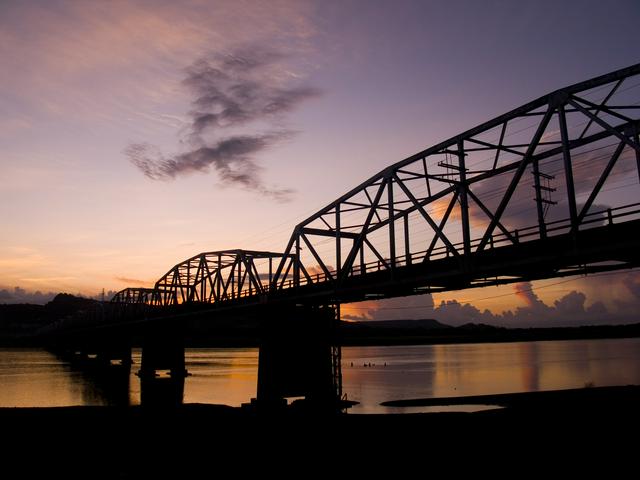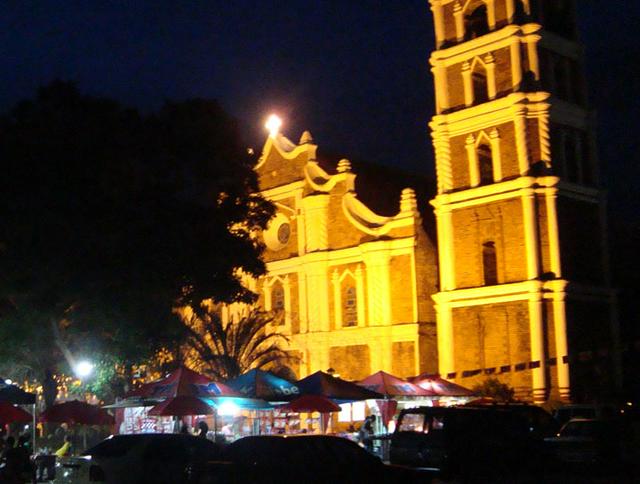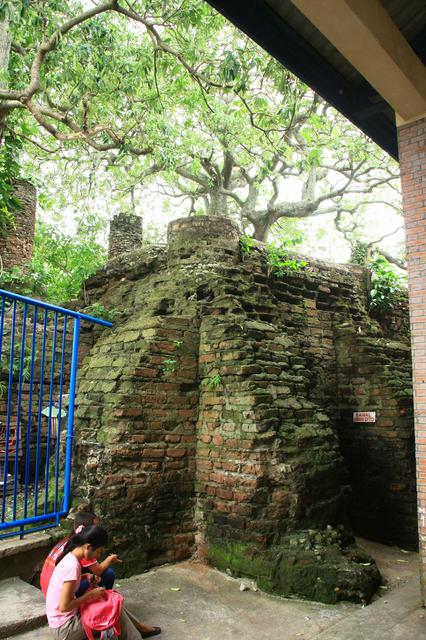Tuguegarao is the provincial capital of Cagayan, and the regional center of Cagayan Valley, with a reputation for hot weather.
Lying at a plain surrounding the meandering Cagayan River, Tuguegarao is the most populated and the only city in Cagayan province, and is the transportation hub for the region. The population is around 154,000 in 2015.
Tuguegarao is at the homeland of the Ibanag and the Itawis, both living along the banks of the Cagayan River. Those ethnic groups, along with their native languages, continue to exist today, despite the Ilocano migration from the 1900s displacing them.
Tuguegarao's name is shrouded in legend and historical debate, and there is little information about Tuguegarao before the Spaniards arrived, but some land documents specify that it was called Tubigarao, an Ibanag settlement. The most accepted origin of the name "Tuguegarao" is the Ibanag phrase tuggi gari yaw, which means "this was cleared by fire", a reference to the ancient practice of slash-and-burn agriculture.
The American colonial era brought changes to Tuguegarao, becoming the provincial capital in 1909 with the construction of a new provincial capitol. It was then a town, with a traditional market, high school, and a trade school. The Japanese captured Tuguegarao during an invasion from Aparri in 1941, but the Philippine army and constabulary, and an American are able to secure a foothold on the town and establish a headquarters there. Further changes happened in 1975, when Tuguegarao became the regional capital of the new Cagayan Valley region, and in 1999, gained city status.
With its inland location, nestled between the Cordilleras to the west and the Philippine Sea to the east, Tuguegarao has a fair reputation for extremes, with a record high of, and a record low of . Tuguegarao is the hottest city in the Philippines, with Cabanatuan far south at second. The climate somewhat combines savanna, rainforest, and subtropical climates, with highs hovering around and lows around, so dry season is brutal, rainy season have hot mornings followed by rainy afternoons or unpredictable rainfall, and the cool season can be as cold as Baguio due to the northeast monsoon.
Cool season runs from December to February, when the northeast monsoon (amihan) is at full blast. The cool, dry wind from Siberia directly hits the city, so the nighttime low can drop below, or even below .
Hot season spans the months of March and April, and is brutal, with the heat index around the 40s or even extreme, the range.
Rainy season covers much of the year from May to November. Rainy weather on the early part is due to moist Pacific air, which gives way to the northeast monsoon by November. October is the rainiest month, and typhoons pass through Tuguegarao between August and October.



- Buntun Bridge. One of the longest bridges in the country at 1.124 km (0.698 mi). It is 2.5 km (1.6 mi) from the city proper and offers an unobstructed view of the Cagayan River.
- Sts. Peter and Paul Metropolitan Cathedral, Rizal Street, Barangay Centro 10. The seat of the Archdiocese of Tuguegarao. The Diocese of Tuguegarao was erected on April 10, 1910. Pope Paul VI elevated the Diocese of Tuguegarao into an Archdiocese on September 21, 1974. The church with the belfry is the biggest Spanish colonial church in Cagayan Valley built by the Dominicans who came to evangelize Cagayan Valley. It was constructed from January 17, 1761 to 1767 under the supervision of Fr. Antonio Lobato, OP. The cathedral suffered massive destruction in World War II losing its pipe organ, three wooden retablos, pulpit, wooden choir loft and the painted wooden ceiling all of which were from the early 18th century. The old convent adjacent to the cathedral church was also razed to the ground during the war and was demolished to make way for a new one. The complex was rebuilt by Msgr. Bishop Constance Jurgens who is now entombed inside the church. The Cathedral is also said to be one of the beautiful structures that stood in the land and because of that impression, its portrait can also be seen in Vatican City. The traditional ringing of the cathedral bells for the Angelus and during Mass is still being practiced today.
- St. Hyacinth Church, Mabini Street. An elevated historic chapel established in 1604, 100 years older than the Sts. Peter and Paul Cathedral. American soldiers during the Philippine-American War used it as headquarters in 1899. St Hyacinth is the patron saint of the city whose feast is celebrated every August 15 coinciding with the Pav-vurulun Festival. The oldest brick structure in the city is the first parochial building built by the Dominican fathers in Tuguegarao. The current structure is the latest in a process of rebuilding beginning in 1724, in 1892 after it was destroyed by an earthquake and reconstruction after World War II. The chapel was not heavily damaged during the war and as a result retains its original wooden retablo which dates to the 18th century.
- Cagayan Provincial Museum and Historical Research Center, National Highway, Provincial Capitol Complex, +63 78 846 7337. At the provincial capitol complex, it was conceived by the Provincial Board in 1971 and became operational on its inauguration on August 15, 1973 during the traditional Aggao na Cagayan. It is a general museum that houses an extensive collection of artifacts, antiques, ethnography, trade wares, heirloom pieces and liturgical works of the province and fossils of animals that once roamed the valley. The museum houses extensive data on the discovery of Callao Man by the National Museum of the Philippines. The center is 5 km (3.1 mi) from Tuguegarao.
- St. Paul University Philippines, Mabini Street. It was founded by the Sisters of St. Paul of Chartres in 1907, who came to Cagayan upon the invitation of Bishop Dennis Dougherty. The school had its operation in a Spanish Convento, adjoining the Cathedral of Tuguegarao. The institution transferred to its present location in 1934 after it was acquired from the Dominican Order. The entire building complex became hospital and garrison of the Japanese forces during World War II and was bombed by the combined American and Filipino ground troops during the liberation in 1945. The institution became the first Catholic University in Region II in 1982 and the first private Catholic University in Asia and the Philippines to be granted ISO 9001 Certification by TUV Rheinland in 2000.
- Horno Ruins, Barangay Centro 09 (Bagumbayan). A Spanish-era brick kiln located at Barangay Bagumbayan. This was used to fire bricks to be used for various structures during the Spanish colonial era in Tuguegarao such as the Tuguegarao Cathedral and the San Jacinto chapel. It is found besides a basketball court.
Buntun Bridge. One of the longest bridges in the country at 1.124 km (0.698 mi). It is 2.5 km (1.6 mi) from the city proper and offers an unobstructed view of the Cagayan River.
Sts. Peter and Paul Metropolitan Cathedral, Rizal Street, Barangay Centro 10. The seat of the Archdiocese of Tuguegarao. The Diocese of Tuguegarao was erected on April 10, 1910. Pope Paul VI elevated the Diocese of Tuguegarao into an Archdiocese on September 21, 1974. The church with the belfry is the biggest Spanish colonial church in Cagayan Valley built by the Dominicans who came to evangelize Cagayan Valley. It was constructed from January 17, 1761 to 1767 under the supervision of Fr. Antonio Lobato, OP. The cathedral suffered massive destruction in World War II losing its pipe organ, three wooden retablos, pulpit, wooden choir loft and the painted wooden ceiling all of which were from the early 18th century. The old convent adjacent to the cathedral church was also razed to the ground during the war and was demolished to make way for a new one. The complex was rebuilt by Msgr. Bishop Constance Jurgens who is now entombed inside the church. The Cathedral is also said to be one of the beautiful structures that stood in the land and because of that impression, its portrait can also be seen in Vatican City. The traditional ringing of the cathedral bells for the Angelus and during Mass is still being practiced today.
St. Hyacinth Church, Mabini Street. An elevated historic chapel established in 1604, 100 years older than the Sts. Peter and Paul Cathedral. American soldiers during the Philippine-American War used it as headquarters in 1899. St Hyacinth is the patron saint of the city whose feast is celebrated every August 15 coinciding with the Pav-vurulun Festival. The oldest brick structure in the city is the first parochial building built by the Dominican fathers in Tuguegarao. The current structure is the latest in a process of rebuilding beginning in 1724, in 1892 after it was destroyed by an earthquake and reconstruction after World War II. The chapel was not heavily damaged during the war and as a result retains its original wooden retablo which dates to the 18th century.
Cagayan Provincial Museum and Historical Research Center, National Highway, Provincial Capitol Complex, +63 78 846 7337. At the provincial capitol complex, it was conceived by the Provincial Board in 1971 and became operational on its inauguration on August 15, 1973 during the traditional Aggao na Cagayan. It is a general museum that houses an extensive collection of artifacts, antiques, ethnography, trade wares, heirloom pieces and liturgical works of the province and fossils of animals that once roamed the valley. The museum houses extensive data on the discovery of Callao Man by the National Museum of the Philippines. The center is 5 km (3.1 mi) from Tuguegarao.
St. Paul University Philippines, Mabini Street. It was founded by the Sisters of St. Paul of Chartres in 1907, who came to Cagayan upon the invitation of Bishop Dennis Dougherty. The school had its operation in a Spanish Convento, adjoining the Cathedral of Tuguegarao. The institution transferred to its present location in 1934 after it was acquired from the Dominican Order. The entire building complex became hospital and garrison of the Japanese forces during World War II and was bombed by the combined American and Filipino ground troops during the liberation in 1945. The institution became the first Catholic University in Region II in 1982 and the first private Catholic University in Asia and the Philippines to be granted ISO 9001 Certification by TUV Rheinland in 2000.
Horno Ruins, Barangay Centro 09 (Bagumbayan). A Spanish-era brick kiln located at Barangay Bagumbayan. This was used to fire bricks to be used for various structures during the Spanish colonial era in Tuguegarao such as the Tuguegarao Cathedral and the San Jacinto chapel. It is found besides a basketball court.
- Pav-vurulun Festival: - week-long, ends in 16 August (annually). Pav-vurulun is an Ibanag word which means get-together or a sense of belonging. It is in this context that the city annually celebrates its patronal fiesta in honor of St. Hyacinth, the patron saint of the city. It gathers Tuguegaraoeños to a week-long festivities culminating with a mass and procession of the patron saint on August 16. The week-long celebration is a festival of activities marked by parades, beauty contests, Pancit Batil-Patung eating contest, street dancing competition, music festival, sports fest, and trade fairs among others.
It is now called the Pavvurulun Afi Festival, a fire-themed festival. Afi is an Ibanag word which means fire, signifying the city's etymology. A highlight of the celebration was the lighting of bamboo torches by more than 3,000 college students from Cagayan State University as part of the kick-off activities. The organizers used citronella oil instead of kerosene, as a safety precaution, to ignite the torches.
Pav-vurulun Festival: - week-long, ends in 16 August (annually). Pav-vurulun is an Ibanag word which means get-together or a sense of belonging. It is in this context that the city annually celebrates its patronal fiesta in honor of St. Hyacinth, the patron saint of the city. It gathers Tuguegaraoeños to a week-long festivities culminating with a mass and procession of the patron saint on August 16. The week-long celebration is a festival of activities marked by parades, beauty contests, Pancit Batil-Patung eating contest, street dancing competition, music festival, sports fest, and trade fairs among others.
- SM Center Tuguegarao Downtown, Luna Street cor. Mabini Street. 9AM-10PM. SM Center Tuguegarao Downtown has a gross floor area of almost 37,000 m². SM Supermarket, cyberzone and food and nonfood retail tenants.
- SM City Tuguegarao. SM City Tuguegarao is scheduled to open in 2018, has a gross floor area of almost 90,000 m². Anchor tenants are SM Store and SM Hypermarket. The mail wiil also have Cinemas, foodcourt, cyberzone and amusement center.
- Robinsons Place Tuguegarao, Tanza, Tuguegarao City, Cagayan.
SM Center Tuguegarao Downtown, Luna Street cor. Mabini Street. 9AM-10PM. SM Center Tuguegarao Downtown has a gross floor area of almost 37,000 m². SM Supermarket, cyberzone and food and nonfood retail tenants.
SM City Tuguegarao. SM City Tuguegarao is scheduled to open in 2018, has a gross floor area of almost 90,000 m². Anchor tenants are SM Store and SM Hypermarket. The mail wiil also have Cinemas, foodcourt, cyberzone and amusement center.
Robinsons Place Tuguegarao, Tanza, Tuguegarao City, Cagayan.
- Luna Streat Foodpark.
Luna Streat Foodpark.
- Pagudpud
- Laoag
- Solano (Philippines)
- Callao Cave. In Peñablanca town east of Tuguegarao. A limestone cave and one of the most popular tourist destinations of the province. It is the location of the oldest human remains found in the Philippines known as the Callao Man.
Callao Cave. In Peñablanca town east of Tuguegarao. A limestone cave and one of the most popular tourist destinations of the province. It is the location of the oldest human remains found in the Philippines known as the Callao Man.
